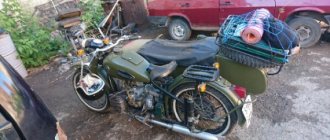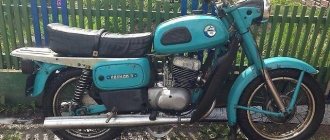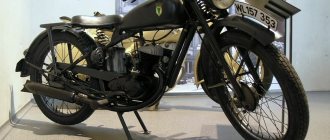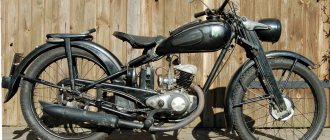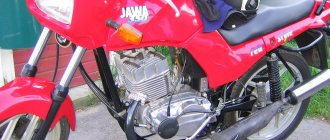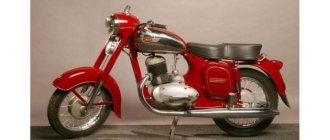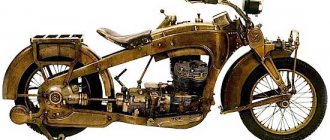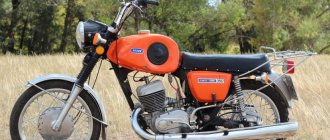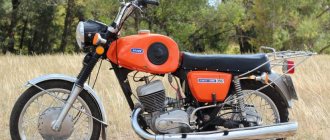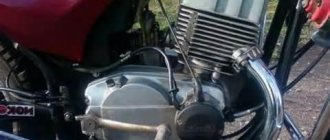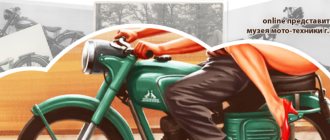At one time, perhaps, there was not a teenager in the USSR who did not dream of becoming the owner of a Java motorcycle. At that time, the products of the Czech brand were one of the most popular. Largely thanks to Java, a new subculture began to emerge in our country: bikers in leather jackets and on iron horses.
With the collapse of the Soviet Union, the popularity of the Czech classics gradually faded and was replaced by other models. However, true connoisseurs are interested in what the once popular motorcycle manufacturer is now producing.
Excursion into history
When Java was popular there was no Internet, so the history of the motorcycle was unknown to few people. People were satisfied that the bike looked cool, was fast and reliable. And everything else was not important then. However, some believed that Java's popularity was due to the fact that it simply had no competitors at the time.
This is an erroneous opinion, since at the same time the motorcycle took part in various sports competitions. He showed himself best on speed tracks. Java was ridden by such successful riders of the time as Bari Briggs from New Zealand and Oli Olsen from Denmark. Largely thanks to the Czech motorcycle, they were able to become world champions.
With the advent of Internet access, studying the history of the Czech brand has become very easy. The plant was founded in 1929. Jawa began supplying its products to the USSR after the end of the Second World War. Initially, 100 thousand motorcycles per year came to our country. In 1964, a significant event occurred: the millionth Java came off the assembly line. Further, the rate of production increased, and already in 1976 the total circulation amounted to 2 million.
The most popular motorcycle of the Czech plant was considered the Java 638, released in 1984. After this, production of its modifications began. Two years later, a new model 350-638-00 appeared. After this, the modernization of the “classics” continued and in 1990 the Java 350-638 rolled off the assembly line.
Why did they buy it?
This motorcycle is known for its speed performance: “Java” was bought by those who could not live without the feeling when adrenaline is pumped into the blood, a feeling of euphoria arises. The motorcycle gave an incredible riding experience. Moreover, when a Jawa drove past the owners of Jupiter, Voskhod or IZh, it did not go unnoticed. This technique was known to everyone for its good performance characteristics; moreover, the elegant design of the motorcycle and the pleasant sound of the engine attracted attention. As for the model range, immediately after the end of the war the Jawa 250 appeared, and three years later the Jawa 350. These models sold like hotcakes in the USSR. The high cost did not scare away motorists either - 650 rubles was a lot of money for that time. But everyone understood perfectly well why they were giving such money, and had an idea of what they would receive in return. This brand symbolized reliability, prestige and high status.
The model range includes the following positions - Jawa 50, 125, 350, 650 and so on. Here you can find suitable motorcycle equipment for both beginner speed enthusiasts and experienced motorcycle enthusiasts. Equipment such as the Jawa 650 Dakar/Sportard is equipped with a 650 cc engine. There is the Jawa 650 Style, a motorcycle that is balanced in its characteristics. It is designed specifically for comfortable travel over long distances. The decline of Jawa production came with the collapse of the Soviet Union. The company was left with outdated models, although there were patents for various technologies that Czech engineers came up with, but they were used by completely different companies. It was thanks to patents that Java continued to exist in the future, but never became a global manufacturer. They began to produce budget motorcycles that can compete in their segment, but the level of interest in new models is noticeably lower than before. The modern Java is built on its own chassis and equipped with foreign-made engines; the chassis, as before, is quite reliable.
Return of a legend: Jawa will soon launch a new motorcycle
Looking at the photo in the title, experienced motorcyclists will definitely remember the paint, which over time changed color from scarlet to cherry, chrome with a bluish tint and the bass rumbling of a long-stroke 2-stroke...
And they will be completely right: in the photo there is a new engine of the legendary Java, which will soon return to the motor market with a new motorcycle model.
This motor looks very similar to the old lady's power unit, but in fact it has a modern design. It is 4-stroke, liquid-cooled, 4 valves per cylinder and 2 camshafts in its head. Under the characteristic oval cover with fins, it is not the Jikov carburetor that is hidden, but an injector.
The volume of this 1-cylinder engine is 300 cc. cm., power - 27 l. s., torque - 28 Nm. It is coupled with a 6-speed gearbox.
The origin of the engine is Indian: 60% of Jawa shares belong to the Mahindra Group. He intends to seriously expand the volume and model range of his motorcycles, as well as their sales market, for which he is buying up famous brands in the past.
You can guess from the design of the motor. that the new “Java” will resemble the famous “old lady”
It is still unknown what the motorcycle will look like - there is only information about 3 models on the same base. But judging by the design of its engine, retro style will certainly be present there. However, there is not long to wait - the official presentation of the motorcycle will take place on November 15.
By the way, the revived Java will, first of all, be exported to India. This brand is known there no less than in the former USSR - back in 1960, the Ideal Jawa Ltd plant was opened in the city of Mysore, which assembled Jawa 353/04 motorcycles and Jawa Pioneer scooters.
Yezdi Model A
In 1974, Ideal Jawa Ltd changed its name to Yezdi and began producing the then new “Java-634”. Even earlier, the Indians switched from screwdriver assembly to the independent production of some components: gas tanks, fenders, glove compartments, mud flaps, etc. This did not affect the quality - Yezdi motorcycles were successfully exported to a dozen countries, right up to Guatemala.
Yezdi Jet 50 - former "Java Pioneer"
And in India itself, Jawa and Yezdi received cult status. Despite the fact that the production of Yezdi motorcycles ceased back in 1996, and the export of Yavs even earlier, in India there is a large fan club of fans of these brands, which holds regular rallies. Therefore, the new motorcycle will most likely be received with enthusiasm there.
Modern Jawa 350 OHC
Jawa is alive and now, however, it is not producing its own models, but a few retouched Chinese classics Shineray XY400 with 1-cylinder 4-stroke engines. They simply install tanks and glove compartments from the Java-634, as well as other saddles in its own style.
Unit donor - Chinese Shineray XY400
Therefore, the joint work of Java and Mahindra can truly be considered a revival of a brand that was legendary in the past.
History of production development
The sale of Java motorcycles in the USSR was very successful. And the reason was that they were head and shoulders above all brands of Soviet equipment produced at that time.
The production of this motorcycle took place in Czechoslovakia, and it owes its name to the name of the head of the company - Frantisek Janicek and the company Wanderer, from which he acquired all rights and licenses.
Janicek first produced a motorcycle under the Java brand in 1929. Now hardly anyone except connoisseurs knows what this model looked like. In addition, the first pancake turned out to be lumpy, as always, and the motorcycle was not a success. But the next brainchild of the Czech, created in 1931 - a 175 cc light motorcycle, became popular. Three years later, a model with a 4-stroke engine with a volume of 350 cm3 appeared, and in 1937 they released a very interesting motorbike, which received the unusual name Java-Robot.
After the Germans entered the Czech Republic, work at the plant did not stop. The production of two-stroke engines of 250 and 350 cc began.
In 1945, when the country was liberated from the occupiers, the plant became state property. A year later, the new Java 250 received gold at an exhibition in Paris.
The Java motorcycle has repeatedly become a winner in speedway and motocross. World championships were won without any problems. The peak of fame was the 60-70s. Well-known names in the speedway world such as Barry Briggs, Ole Olson and Ivan Major performed in Java. We don’t forget about cross-country motorcycles, which were mass-produced in the 70-80s and had considerable popularity.
You may also be interested in: The main types of motorcycles: choosing an “iron horse”
At all times, the motorcycles of this company were famous for their high quality and excellent performance.
Java with engines of 250 and 350 cm3 are still produced.
The Java 350-634 motorcycle went into mass production by 1973. This is one of the most popular models in the countries of the socialist camp. It had not only excellent driving characteristics, but also an excellent design. By the way, not everyone knows that in the early eighties this Java 350 model experienced a kind of rebirth and turned into what we know today as the Java 638 motorcycle.
This technique was so famous that it appeared in Soviet cinema more than once. Moreover, in the most famous films. 350 – ka with a stroller ended up in the film “The Diamond Arm”. The hero A. Mironov drives it. And Karachentsov drives a Jawa 634 in the film “The Adventures of Electronics.”
Java has always been a living legend. And if some Ural motorcycle became the hero of jokes, then this technique was always valued. There were queues for the 350, so many people preferred to buy a motorcycle with a smaller engine capacity, so as not to wait so long.
This company produced both excellent sports motorcycles and reliable models for city trips.
The collapse of the USSR hit production hard, but a miracle happened and the plant was able to survive, maintaining production. Production of models with higher power Honda and Rotax engines began.
In 2007, a very interesting new motorcycle, the Jawa 250 Travel, appeared. Simple in design and based on Java 350, it turned out to be very reliable and high quality.
The car received a 2-cylinder four-stroke engine with a power of 13 kW at 7500 rpm. Speed – 120 km/h.
A good motorcycle for traveling around the city and country roads of decent quality. If you don't try to drown the car in the mud, it performs quite well. Jawa 250 Travel is a reliable workhorse that will serve you faithfully for many years. These Java motorcycles are new and quite modern. There is good suspension, comfortable control, high-quality brakes - front disc, rear - drum.
You may also be interested in: Everything about streetfighter motorcycles and their owners
Many years have passed since the Soviet glory. Then the plant managed to sell more than a million 250 and 350 cc motorcycles to our country. Since then, Java has re-equipped production in the Czech Republic and opened dealership centers in many countries. Old classic models are still popular around the world, and new ones are gaining fame.
Even the most modern Java motorcycle has a lower price than Japanese or Korean equipment.
Video history of Java motorcycles:
